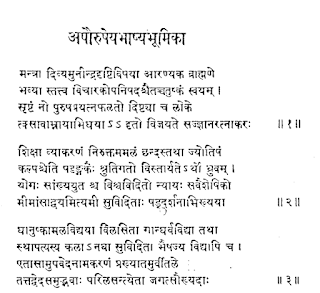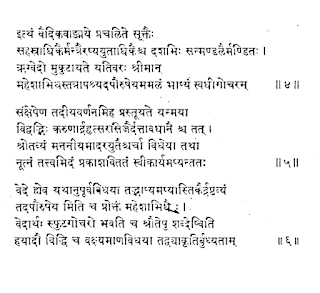by
Pandit T. V. Parameshvara Iyer
Professor of Sanskrit Literature, Maharishi European Research University, Switzerland, 1979
Herein I give the translation of my poem of eleven Verses in Sanskit ertitled
APAURUSHEYA BHASHYA BHUMIKA:
Verse 1
It is the fortune of the world that an ocean of the jewels of perfect knowledge reigns supreme here. It is not the creation of human effort, and it consists of the four branches of treatises known as MANTRAs, ARANYAKAs; BRAHMANAs and the UPANISHADs or metaphysical section. They have been visualized by the sages of yore, endowed with divine wisdom.
Verse 2
The meanings of the Vedas are explained and expatiated upon by the six ANGAs or ancillary subjects named SHIKSHA; KALPA, VYAKARAN, NIRUKT, CHANDAS, and JYOTISH. The UPANGAs are well known by the name of six systems of philosophy, and they are NYAYA, VAISHESHIK, SAMKHYA, and the two MIMANSAs.
Verse 3
Verse 3
The name UPÄVEDA is famous for the sciences of archery, music, construction, and medicine. They have originated from the different VEDAs, and they are conducive to the wellbeing of the whole wor1d.
In the midst of this extensive Vedic Literature RGVEDA can be considered the Crest Jewel, It consists of ten MANDALAs, more than a thousand SUKTAs (hymns) and more than ten thousand MANTRAs or verses. It is in this that MAHARISHI MAHESH YOGI has cognized the splendid APAURUSHEYA BHASHYA.
Verse 5.
A brief mention of-the same is given by me here. Learned men of sympathetic consideration must look into it attentively, ponder over it respectfully, and discuss it thoroughly. This new principle which has been brought into light now has to be accepted ultimately.
Verse 6.
Believers in the Vedic wisdom can see the elucidation of the Vedic words in the Veda itself in the sequence of the words themselves. This has to be borne in mind at the outset, and its further exposition is as follows.
Verse 7
The first Hymn on AGNI in the RGVEDA is the most important; the first MANTRA and the very first word AGNIM are-all very important. This is axiomatic in our belief and should not be doubted at all.
Verse 8.
There is an AVYAKTA or unmanifest SUKTA after the 96th hymn. It is diagonally opposite to the first SUKTA. The suffering of the world is due to our forgetting, the same. F'or the welfare of the world the Vedic Pundit must bear this in mind while reciting the VEDAs regularly.
Verse 9
All people know that the number of SUKTAs in the first and the tenth MANDALA is the same, viz 191. The numbers shall be written in a circle and placed one over the other so that there is no gap in between.
Verse 10
Superimposing the SUKTAs of the two MANDALAs fulfil the deficiencies if arry in each other. The meanings and implications of the different MANTRAs must be considered duly. See thus, O Pundits, the eternity of the VEDAs based on indestructibility. What else need to be said in this respect?
Verse 11.
Thus, the APAURUSHEYA BHASHYA has been enunciated here briefly. The full explanation of the same is to be understood by the Pundits from the extensive Videotapes of the different talks by MAHARISHI MAHESH YOGI, the talks that are pleasing to the ears and the pictures that are pleasing to the eyes. They are exhortative.




